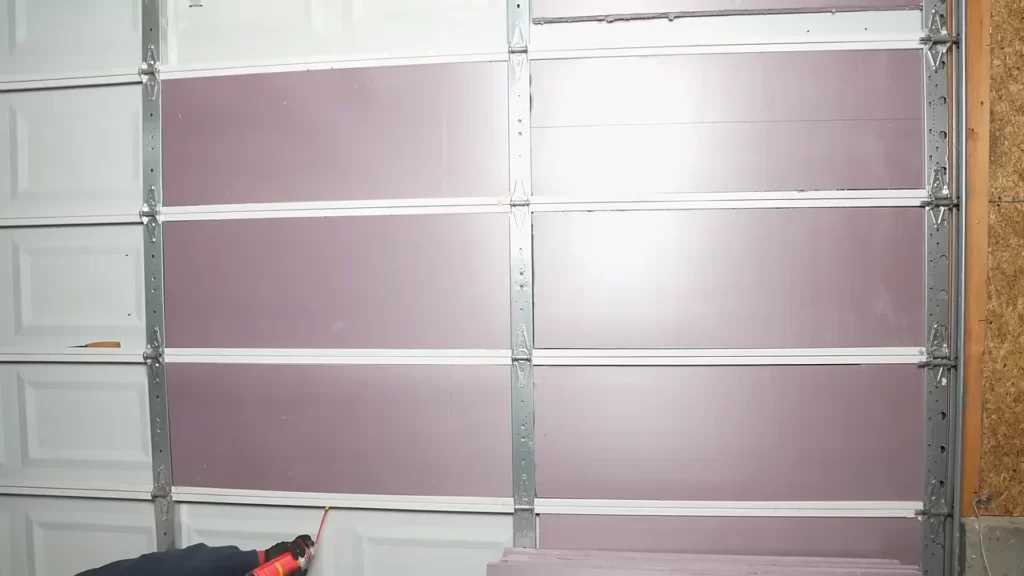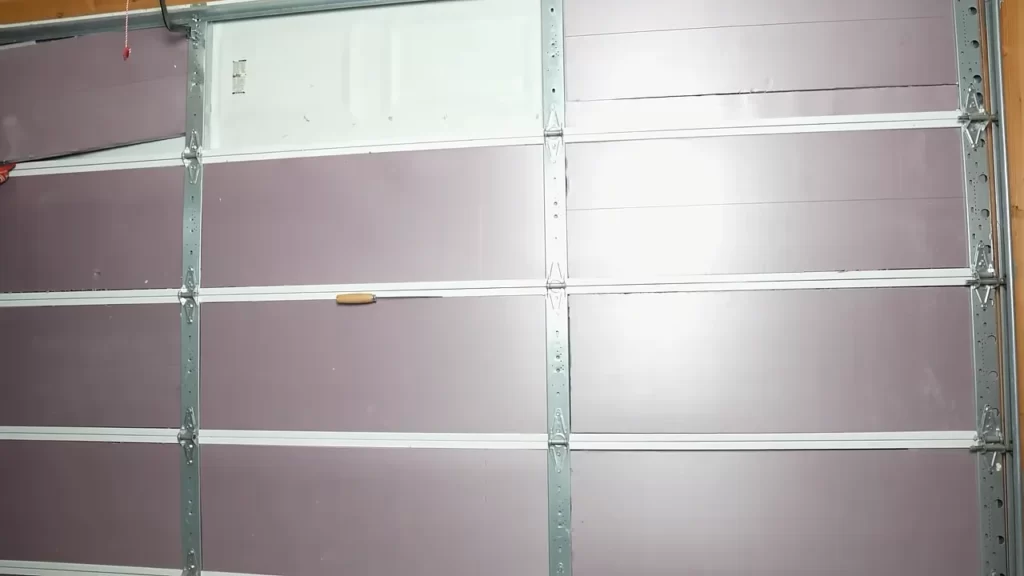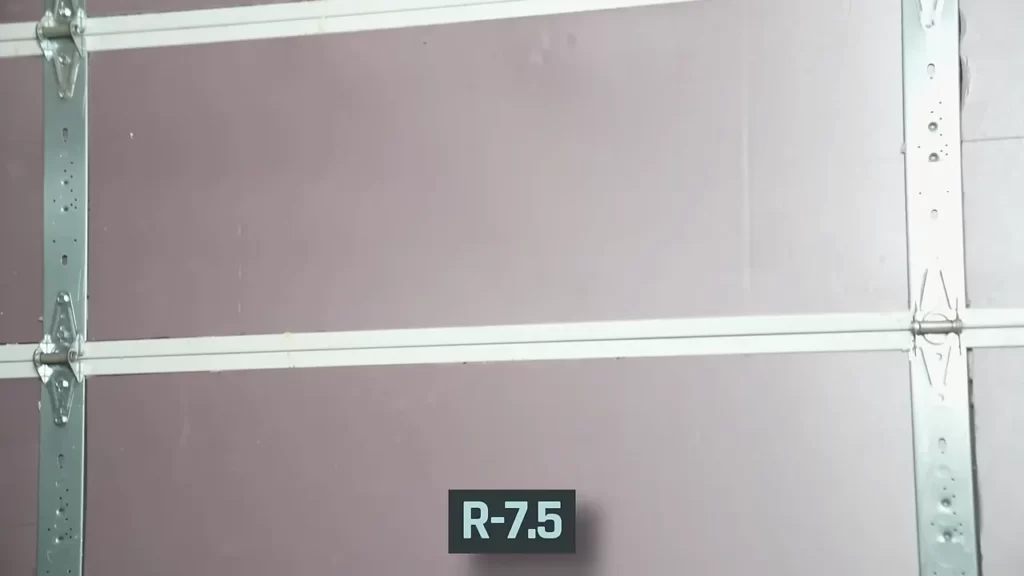To install garage door insulation, you need to measure the door panels and cut the insulation material to fit them. Then, attach the insulation to the panels using adhesive or fasteners.
Benefits Of Garage Door Insulation
html
Improved Energy Efficiency
Garage door insulation can significantly improve energy efficiency in your home. By insulating your garage door, you can prevent heat from escaping during the winter and keep cool air inside during the summer. This results in reduced energy consumption and lower utility bills. Insulation helps create a barrier that prevents the transfer of heat between your garage and the outside environment, keeping the temperature inside more stable.

Noise Reduction
Additionally, garage door insulation provides excellent noise reduction benefits. It helps to absorb sound and minimize the transmission of noise from outside sources, such as traffic, lawnmowers, or barking dogs. This can create a quieter and more peaceful environment inside your home, especially if your garage is attached to your living space.
Protection From Extreme Temperatures
Garage door insulation acts as a barrier against extreme temperatures. It helps to regulate the temperature inside your garage, preventing it from becoming too hot or too cold. This is particularly beneficial if you use your garage for purposes other than storing your vehicle, such as a home gym or workshop. Insulation can also help protect any belongings stored in the garage from potential damage due to extreme temperatures.
How To Choose The Right Garage Door Insulation
When choosing garage door insulation, it is important to consider the R-value, types of insulation materials, and compatibility with the garage door material.
The R-value is a measure of thermal resistance, indicating how well the insulation prevents heat transfer. Higher R-values are recommended for colder climates, while lower R-values are suitable for milder temperatures.
| Type of Insulation Material | Pros | Cons |
|---|---|---|
| Fiberglass | Effective thermal insulation, affordable | Can irritate skin and respiratory system during installation, may sag over time |
| Polyurethane Foam | Highly efficient insulation, strong and durable | Expensive, requires professional installation |
| Reflective Foil | Reflects radiant heat, easy to install | Not as effective for insulation in colder climates |
Compatibility with the garage door material is also crucial. Some insulation materials may not be suitable for certain garage door materials, such as wooden doors that require breathable insulation to prevent moisture buildup.
By considering these factors, you can choose the right garage door insulation that meets your specific needs and ensures energy efficiency and comfort in your garage.
Measuring The Dimensions Of The Garage Door
When installing garage door insulation, it is important to properly measure the dimensions of the garage door. This will ensure that you purchase the correct amount of insulation and that it fits properly. To measure the dimensions of the garage door, you will need a few tools, including a tape measure and a pencil or marker. Start by measuring the width of the door, from one side to the other. Then, measure the height of the door, from the top to the bottom. It is also a good idea to measure the thickness of the door, especially if you are planning to use a certain type of insulation that requires a specific thickness. Taking accurate measurements will help you choose the right insulation and achieve the best energy efficiency and noise reduction for your garage.
Gathering The Necessary Tools And Materials

Installing garage door insulation is a great way to improve energy efficiency and reduce noise. To get started, gather the necessary tools and materials. First, you’ll need insulation material suitable for garage doors. Look for options with good insulation properties, such as polystyrene or polyurethane. Adhesive or insulation tape is also important to secure the insulation in place. Make sure to have cutting tools on hand, such as a utility knife or scissors, to trim the insulation to fit your garage door size. Lastly, don’t forget about safety gear, such as gloves and safety goggles, to protect yourself during the installation process.
Step 1: Clean And Prep The Garage Door
To begin the installation of garage door insulation, it is crucial to clean the surface thoroughly. Start by wiping the door with a mild detergent solution to remove any dirt or grease. Rinse it with clean water and allow it to dry completely.
If there is existing insulation on the garage door, you will need to remove it before proceeding further. This can be done by carefully peeling off the old insulation or using a scraper to scrape away any stubborn residues. Ensure that the surface is smooth and free from any debris before moving on.
Step 2: Cut Insulation To Fit Garage Door Panels
To install garage door insulation, one of the important steps is to cut the insulation to fit the garage door panels. This involves measuring and marking the insulation and cutting it with proper tools.
To measure the insulation, use a tape measure to get the dimensions of each garage door panel. Mark the measurements on the insulation material using a marker or pen. Make sure to measure carefully and accurately to ensure a proper fit.
Once the insulation is marked, cut it to size using a utility knife or insulation knife. Follow the marked lines and cut the insulation material along the measured dimensions. Take your time and be cautious while cutting to avoid any mistakes or damage to the insulation.
Repeat this process for each garage door panel, ensuring that the insulation fits snugly and covers the entire surface. By properly measuring, marking, and cutting the insulation, you can effectively install garage door insulation and provide energy efficiency and temperature control in your garage.
Step 3: Apply Adhesive Or Insulation Tape

| Step 3: Apply Adhesive or Insulation Tape |
To ensure a secure bond between the garage door insulation and the surface, you have two options: using adhesive or insulation tape. They both have their advantages, so choose the option that suits your needs best.
Using Adhesive for a Permanent Bond
If you want a long-lasting and permanent solution, adhesive is the way to go. Make sure to clean the surface of the garage door thoroughly before applying the adhesive. Following the manufacturer’s instructions, apply the adhesive evenly on the insulation material. Carefully press the insulation against the garage door, ensuring it adheres properly. Allow sufficient time for the adhesive to set before moving on to the next step.
Applying Insulation Tape for Easy Removal
If you prefer a more flexible and easily removable option, insulation tape is a great choice. Simply measure and cut the insulation tape to the desired length, and then apply it along the edges of the insulation material. Press firmly to ensure a secure seal. Insulation tape is a convenient solution if you may need to remove or replace the insulation in the future, as it can be easily peeled off without leaving residue.
Step 4: Attach The Insulation To Garage Door Panels
Attaching insulation to garage door panels is a crucial step in the installation process. It not only helps to regulate temperature but also provides soundproofing benefits. To ensure proper placement, start by measuring the dimensions of each door panel. Using adhesive spray, apply a generous amount to the back of the insulation and evenly distribute it. Press the insulation firmly against the panel, smoothing out any wrinkles or air bubbles. For added stability, utilize garage door insulation clips to secure the insulation in place. These clips can be easily attached to the sides and bottom of each panel. Make sure to support the insulation with the clips every 12 inches. Lastly, trim any excess insulation using a utility knife for a clean and finished look.
Step 5: Seal Any Gaps Or Edges

After insulating your garage door, it’s important to seal any gaps or edges to maximize the energy efficiency of your garage. Identifying any gaps or openings is the first step. Thoroughly inspect your garage door for any cracks, holes, or spaces where air can escape. These may be located at the sides, top, or bottom of the door.
The next step is to use a suitable sealant or weatherstripping to seal these gaps. Apply the sealant or weatherstripping directly to the gaps, ensuring complete coverage. This will prevent drafts from entering your garage and maintain a consistent temperature inside.
Regularly check for any signs of wear and tear on the sealant or weatherstripping. If you notice any damage, replace it promptly to ensure continued insulation. Following these steps will help you properly seal your garage door and enhance its energy efficiency.
Regular Cleaning And Inspection
Regular cleaning and inspection of your garage door insulation is essential to ensure its optimal performance. Start by removing any dust and debris that may have accumulated on the insulation surface. Use a soft brush, vacuum cleaner, or damp cloth to gently clean the insulation, avoiding any aggressive scrubbing that could damage the material.
Additionally, make it a habit to regularly check for any signs of damage to the insulation. Look for tears, holes, or areas that have become compressed or worn out. If you notice any issues, it’s important to promptly address them to maintain the insulation’s effectiveness. Consider replacing damaged insulation or consult a professional for guidance on how to repair it.

Repairing Or Replacing Damaged Insulation
When it comes to installing garage door insulation, it’s important to address any existing damage before proceeding. If you notice any holes or tears in the insulation, patching them up is a simple solution. Start by cleaning the area around the damaged portion and gather the necessary materials such as foil tape and insulation adhesive. Cut a piece of insulation slightly larger than the hole or tear, and secure it in place using the adhesive. If the damage is extensive or the insulation panels are beyond repair, replacing them entirely may be necessary. Look for compatible insulation panels that fit your garage door’s dimensions and follow the manufacturer’s instructions for installation.
Additional Tips For Garage Door Insulation
Efficiency
To maximize the efficiency of your garage door insulation, consider these additional tips:
- Weatherstripping the Edges of the Garage Door: Adding weatherstripping to the edges of your garage door helps to seal any gaps or cracks, reducing air leakage and improving insulation effectiveness.
- Insulating Garage Door Windows: If your garage door has windows, adding insulation to them can further enhance energy efficiency. You can use insulating materials such as window film or rigid foam insulation to cover the windows.
By implementing these extra measures, you can enhance the insulation properties of your garage door and create a more energy-efficient space.
Frequently Asked Questions Of How To Install Garage Door Insulation
How Do You Stick Insulation To A Garage Door?
To stick insulation to a garage door, follow these steps: 1. Clean the door surface. 2. Measure and cut insulation panels to fit the door. 3. Place adhesive or double-sided tape on the back of the panels. 4. Press the panels firmly onto the door.
5. Secure the panels with sturdy tape or fasteners for added support.
Should Foil Go In Or Out Of Garage Door Insulation?
Foil should go on the inside of garage door insulation. This helps reflect heat and improve insulation.
Should You Put Insulation On Garage Door?
Insulating your garage door is a smart choice. It helps regulate temperature, reduces energy bills, and improves comfort. Insulation keeps the garage cooler in summer and warmer in winter. It also reduces outside noise and makes the door more durable.
Consider insulating your garage door for these benefits.
Conclusion
To sum it up, installing garage door insulation is a cost-effective and efficient way to enhance the energy efficiency and comfort of your home. With just a few simple steps, you can significantly reduce heat loss, noise, and drafts in your garage.
By following the guidelines mentioned in this blog post, you can easily accomplish this project on your own. So, don’t wait any longer – start insulating your garage door today and enjoy the benefits it brings!
